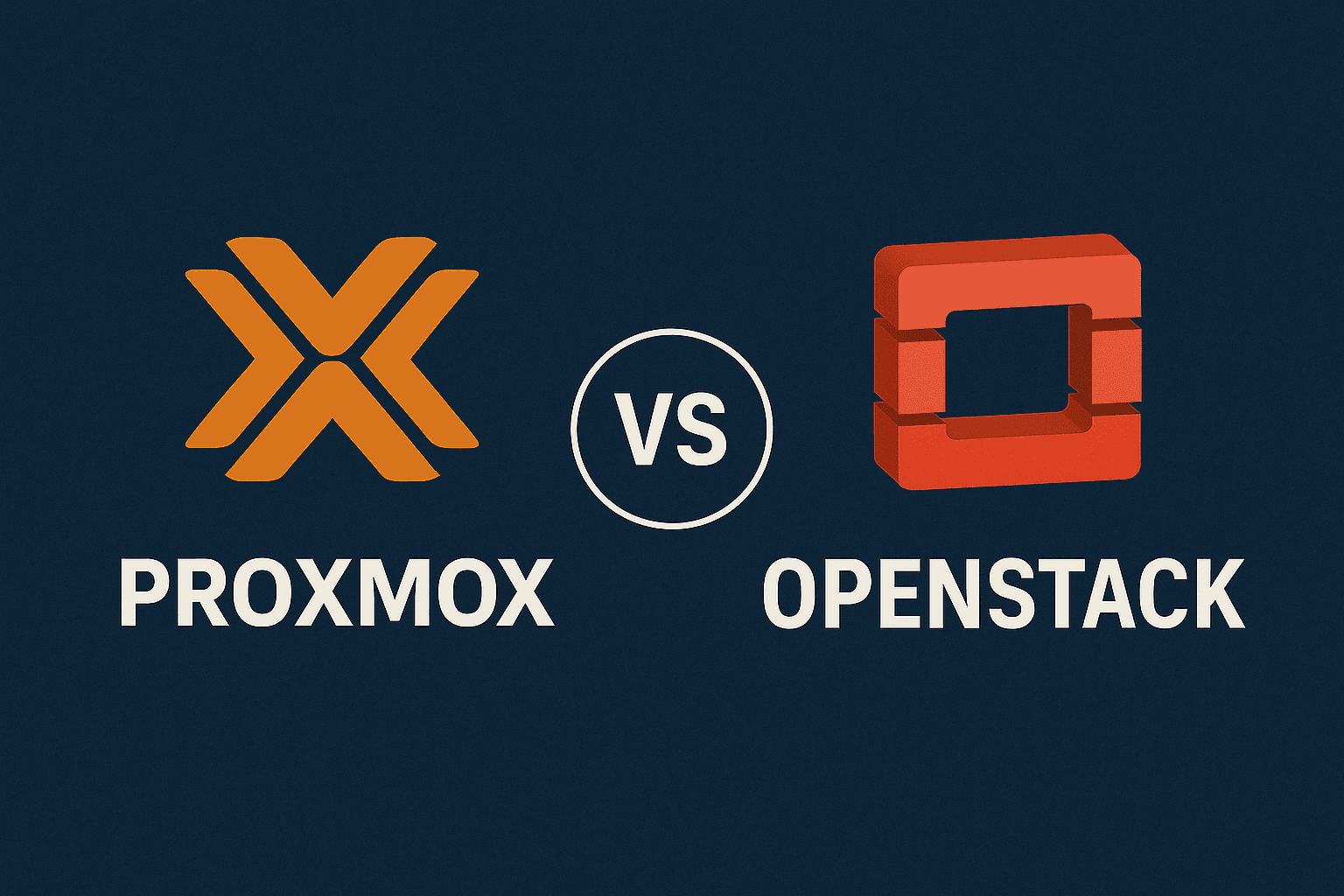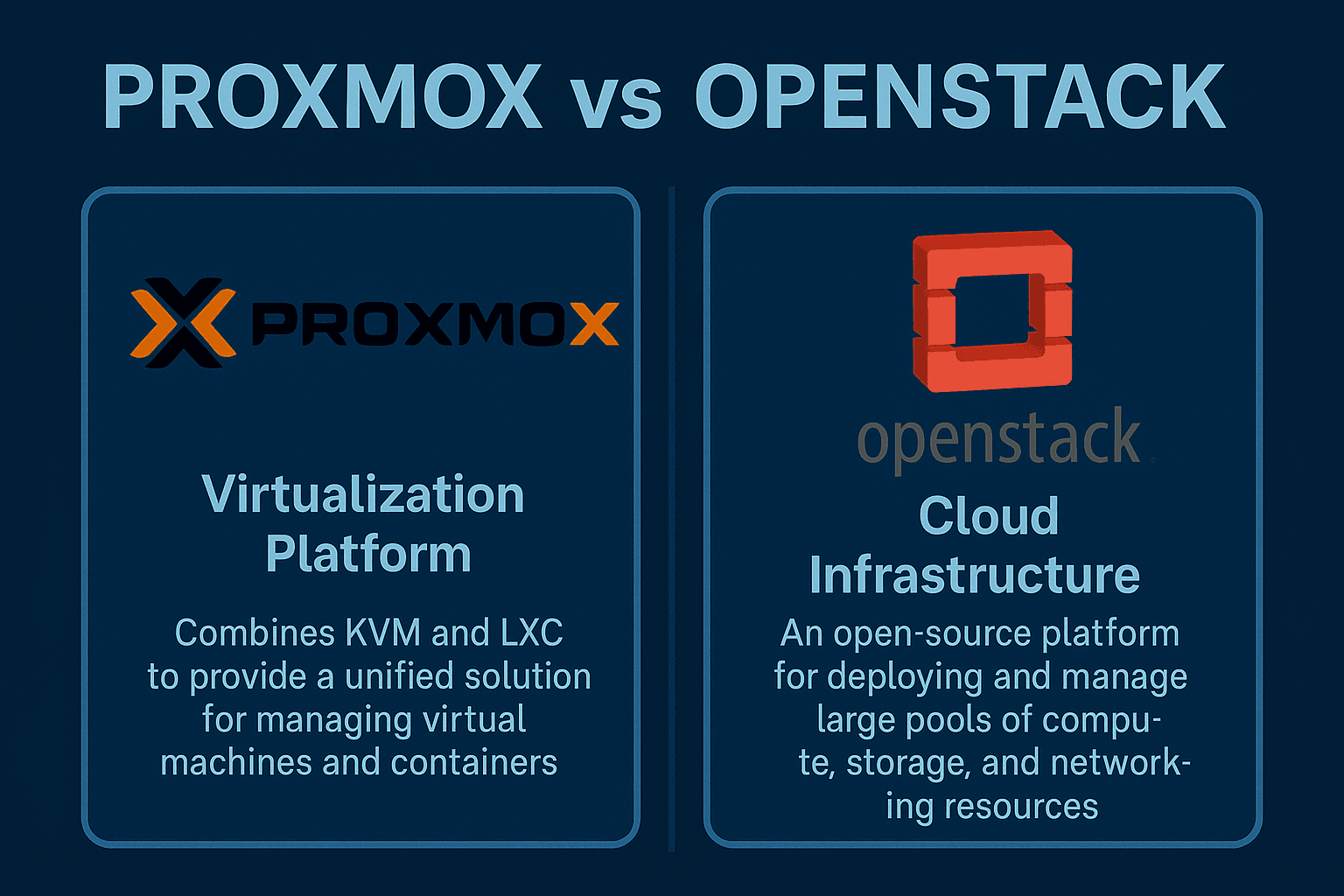
If you’re building a virtualization or private cloud setup, chances are you’ve considered Proxmox and OpenStack. Both are open-source, powerful, and trusted by IT teams — but they solve very different problems.
This guide breaks down Proxmox vs OpenStack to help you decide what’s right for your use case. We’ll look at features, scalability, ease of use, real-world applications, and how Simplyblock helps power both with high-performance, software-defined storage.
🚀 Run Proxmox or OpenStack on High-Performance Storage
Power your virtualization stack with NVMe-over-TCP and auto-managed block storage — built to scale.
👉 Use Simplyblock for Software-Defined Storage →
What Makes Proxmox a Strong Choice for Virtualization
Proxmox is a favorite among developers, sysadmins, and IT teams who want fast, no-fuss virtualization. It’s simple to deploy and doesn’t require heavy infrastructure or cloud orchestration. The Proxmox VE platform supports KVM and containers in a unified interface and continues to gain popularity for edge, lab, and SMB use cases.
Features
- KVM virtualization and LXC containers
- Web-based UI with integrated CLI and REST API
- Native support for ZFS, Ceph, and external storage (such as Simplyblock)
- Cluster support with integrated backup and snapshot tools
Benefits
- Fast, simple setup with minimal hardware
- Ideal for small teams, labs, or edge environments
- No enterprise license fees
- Manage VMs and containers in one platform
Use Cases
- Homelab and test environments
- Lightweight private clouds
- Backup and restore solutions
- SMB virtualization for internal tools or apps
- VM-aware Proxmox storage
What Makes OpenStack Ideal for Private Cloud
OpenStack is designed to run cloud-native infrastructure at serious scale. Its modular design and deep integration make it a powerful choice for enterprises and service providers. The OpenStack architecture enables highly customizable private clouds that support multi-tenancy, automation, and API-driven operations.
Features
- Modular architecture (Nova, Neutron, Cinder, Keystone, etc.)
- Full multi-tenancy and project isolation
- API-driven infrastructure with self-service provisioning
- Advanced storage, networking, and orchestration layers
Benefits
- Highly scalable for enterprise and telco environments
- Fully open-source with wide vendor support
- Supports hybrid and multi-cloud deployments
- Fine-grained control over compute, storage, and networking
Use Cases
- Enterprise private cloud
- Academic and research computing
- Multi-region Kubernetes hosting
- Telco VNF deployments and high-density workloads
- OpenStack-ready software-defined storage

Comparing Proxmox and OpenStack Side by Side
Choosing between Proxmox and OpenStack comes down to scale, complexity, and how much control you need. This table breaks down how they differ in key areas like architecture, storage, and usability.
| Feature | Proxmox | OpenStack |
| Ease of Use | Web UI, fast setup | Complex orchestration, CLI-driven |
| Ideal Use Case | Labs, SMBs, and edge computing | Large-scale cloud infrastructure |
| Architecture | Monolithic, tightly integrated | Modular, highly customizable |
| Compute Models | KVM, LXC | Nova (supports KVM, Xen, more) |
| Networking | VLAN, Linux bridge, simple SDN | Advanced SDN with Neutron |
| Storage Options | ZFS, Ceph, local/NFS | Cinder, Swift, Manila |
| Scalability | Small to mid-sized clusters | Horizontally scalable across regions |
| Community Support | Active but niche | Global, backed by many vendors |
How Simplyblock Strengthens Proxmox and OpenStack Deployments
No matter which platform you choose — Proxmox for simplicity or OpenStack for large-scale control — storage performance often becomes the limiting factor. Simplyblock removes that bottleneck.
Its NVMe-native, software-defined architecture delivers high throughput and low latency to both platforms, without adding complexity. Whether you’re managing a lightweight cluster with Proxmox or a multi-region cloud using OpenStack, Simplyblock adapts to your needs.
Why It Works for Proxmox
- Simplifies external storage integration
- Supports VM snapshots, backups, live-migration, and fast recovery
- Perfect for edge or lab deployments that need reliability without overhead
- Seamlessly integrates with Proxmox VE environments
Why It Works for OpenStack
- Supports scalable, high-performance block storage
- Compatible with OpenStack Cinder through CSI
- Enables disaggregated storage in multi-tenant environments
- Ideal for OpenStack users running Kubernetes-based databases or hybrid workloads
Simplyblock is purpose-built to support the full spectrum of Proxmox and OpenStack use cases — from fast VM provisioning to scalable persistent storage.
Which Platform Fits Your Infrastructure Strategy?
There’s no universal answer — it depends on what you’re building.
If your focus is simplicity, speed, and cost-efficiency, Proxmox delivers a streamlined solution that’s perfect for labs, SMBs, and edge deployments.
If you need scale, deep customization, and full control across compute, storage, and networking, OpenStack is purpose-built for that. It’s the go-to for enterprises running large private cloud environments or service provider infrastructure.
What matters most is pairing the right platform with a storage layer that can keep up, be flexible, high-performance, and ready for dynamic workloads. That’s where Simplyblock fits in.
Questions and answers
Proxmox is a lightweight virtualization platform ideal for running virtual machines and containers with a simple UI. OpenStack is a comprehensive cloud infrastructure framework designed for building scalable, multi-tenant environments. Each serves different infrastructure scales and goals.
Proxmox suits small teams and labs thanks to its ease of use and integrated backup and clustering. OpenStack is better for large enterprises requiring full cloud orchestration. For storage integration, Simplyblock offers persistent volumes for VMs and containers across both platforms.
Yes. Simplyblock supports flexible storage backends for virtual machines, containers, and Kubernetes. Whether you’re using Proxmox or OpenStack, Simplyblock provides NVMe-over-TCP volumes with built-in snapshots, replication, and encryption.
Proxmox integrates with ZFS, Ceph, NFS, and LVM easily. OpenStack uses services like Cinder and Swift to handle block and object storage. Simplyblock enhances both with high-performance NVMe-over-Fabrics access and centralized management.
OpenStack is purpose-built for massive scalability and tenant isolation through native projects and services. Proxmox is simpler and lacks built-in cloud features. If your use case requires isolation and scaling, consider OpenStack paired with Simplyblock’s multi-tenant QoS storage capabilities.
